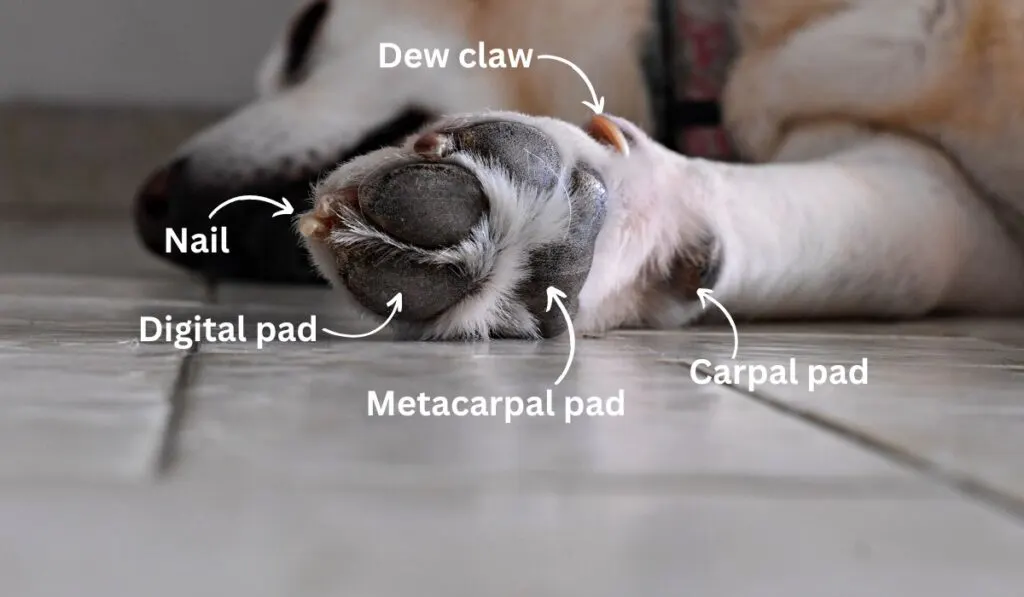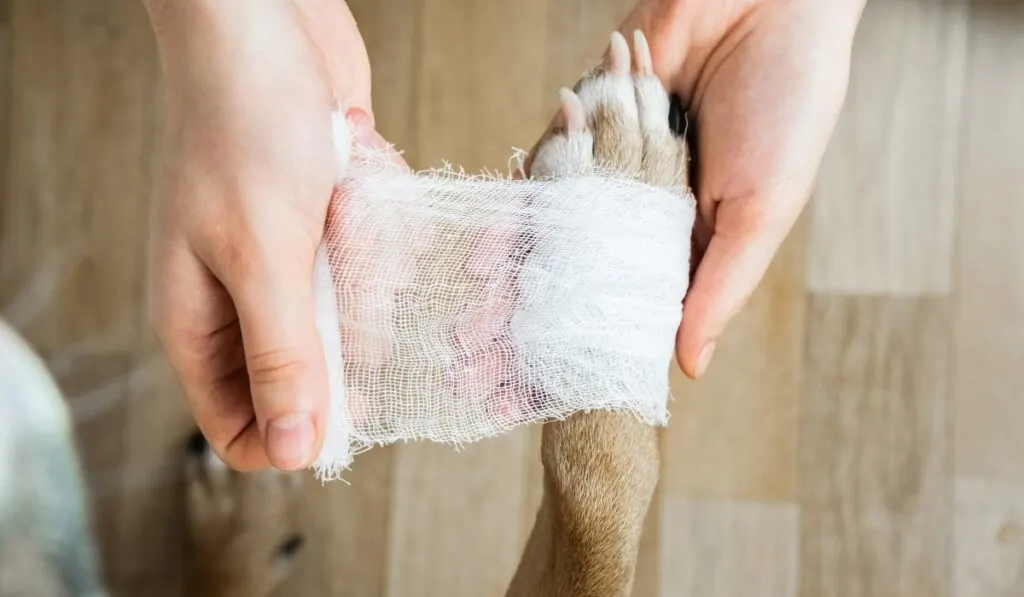Looking after our dogs is sometimes like looking after our kids!
Every now and then our dogs will pick up random injuries that we need to handle in the moment. In most cases we’re able to do this, but what about when its a bent nail?
This article will run through absolutely everything an owner needs to know about their dog’s nail bending sideways.
In most cases, a nail bending sideways is caused by either an injury, grooming accident, nail disease, an excessively long nail or other health issues. In severe cases, professional medical help will be necessary.
Anatomy of a Dog’s Paw

Before getting into the signs and symptoms of a bent/broken nail, let’s cover the real basics of your dog’s paw. This is extremely helpful to know if you’re trying to handle a paw/nail issue.
Claws or Nails
On the edges of each toe, your dog has claws or nails. These grow continuously, much like human nails. Dogs use their nails for digging, gripping onto surfaces, and for defense. Each nail encases a nerve and a blood vessel, often referred to as the ‘quick.’ The quick can be sensitive, which is why a bent or broken nail can cause significant discomfort.
Dewclaws
Some dogs also have an additional nail, known as the dewclaw, located higher up on the leg. It doesn’t touch the ground, but it can serve certain functions depending on the breed, like aiding in gripping objects or for additional traction while running. However, because they don’t naturally wear down from contact with the ground, dewclaws need special attention when it comes to nail trimming.
Digital Pads
Each toe on your dog’s paw has a digital pad underneath. These are smaller pads that provide additional support and cushioning for each toe.
Carpal Pad
This pad is located on the back of your dog’s front leg, above the rest of the paw. The carpal pad acts like a built-in ‘brake’ system for your dog, helping them to stop or turn when running at high speeds.
Metacarpal and Metatarsal Pads
These large, heart-shaped pads are located in the center of your dog’s paw. These pads serve as shock absorbers, protecting your dog’s bones and joints.
By understanding the structure of your dog’s paw, you can be more proactive about their health and wellbeing, noticing any changes or potential issues early on.
Trending: Home Remedies For Redness Between Dog Toes
Symptoms When a Dog’s Nail Has Bent?
Has your dog been showing signs of discomfort?
The first symptom of a bent nail is usually limping or favoring one leg.
Let’s run through the full list of symptoms so you know exactly what to be looking out for!
Remember, you’ll likely notice a combination of physical and behavioral changes, including:
- Limping or Favoring One Leg: The most obvious sign is a change in the way your dog walks. If they’re limping or avoiding putting weight on one leg, it might be due to a bent nail.
- Excessive Licking or Chewing at the Paw: Dogs often try to soothe their discomfort by licking or chewing at the source of their pain. If your dog is paying extra attention to one paw, it could be because of a bent nail.
- Behavioral Changes: Look out for general changes in your dog’s behavior. They might become less active, lose their appetite, or seem more agitated than usual. These changes can indicate your dog is dealing with discomfort.
- Visible Nail Distortion: Upon closer inspection, you might see that one of the nails is twisted or bent. You may also notice swelling or redness around the nail bed. This is a clear sign of a bent nail.
Knowing these symptoms can help you quickly identify when something is wrong and seek appropriate veterinary care. Remember, the quicker the issue is addressed, the sooner your dog will be back to their happy, playful self.
Possible Causes Why a Nail Might Bend Sideways
Understanding the possible causes of bent nails can help in preventing this issue and ensuring your dog stays comfortable. Here are some of the known reasons a dog’s nail might bend sideways.
➡️ Accidental Injury
Accidents happen. Dogs are often active and playful, and during these bouts of activity, a nail can get caught in something and bend. This could happen during a vigorous game of fetch, while exploring in rough terrain, or even during a clumsy fall. Accidental injuries are one of the most common reasons for a bent nail.
➡️ Grooming Accidents
I know so many owners that have tried cutting nails at home, to quickly find themselves rushing to the vets. While cutting nails is generally an easy task, sometimes it could be down to nerves of the owner or the dog making the task at hand difficult, and therefore risky. It’s very common to break a nail, or worse, cut a nail too short, nipping the “quick” and causing heavy bleeding.
➡️ Long Nails
When a dog’s nails are allowed to grow too long, the likelihood of bending or breaking increases. Overgrown nails can easily get caught on carpets, furniture, or other surfaces while the dog moves around. Additionally, the weight of the dog pressing down on overly long nails when walking or running can lead to bending. Regular trimming is important to prevent nails from becoming too long and causing discomfort.
➡️ Genetics
Certain dog breeds may be more prone to nail issues due to their genetic makeup. Some breeds have naturally brittle nails that can easily bend, crack, or break. For instance, breeds like Greyhounds or Boxers are known to have more nail problems than others. Being aware of your breed’s predispositions can help in providing them with the right care.
➡️ Nutritional Deficiencies
The health of your dog’s nails can also be influenced by their diet. Deficiencies in certain nutrients, such as biotin, can lead to weaker nails that are more prone to bending or breaking. A balanced diet, sometimes supplemented with specific vitamins or minerals, can help ensure your dog has strong, healthy nails.
➡️ Underlying Health Conditions
Certain health conditions can also affect the strength and condition of your dog’s nails. For example, conditions that affect a dog’s immune system or hormonal balance can lead to weaker nails. Additionally, infections or infestations can also damage the nails and make them more likely to bend. Regular vet check-ups can help detect and treat these underlying conditions, thus preventing associated nail problems.
Understanding these possible causes can help in preventing bent nails. Always ensure your dog’s nails are appropriately trimmed, provide them with a balanced diet, and schedule regular vet check-ups to catch any potential issues early.

Why It’s Important to Fix a Bent Nail
First and foremost, a bent nail can be very painful for your dog. Fixing it will provide immediate relief and prevent further injury.
Additionally, if left untreated, a bent nail can lead to infections. This happens when the bent nail creates a wound that gets exposed to bacteria. By treating the bent nail promptly, you can avoid a potentially serious infection.
Furthermore, bent nails can cause long-term mobility issues. This is because dogs with a bent nail may adjust their walking or running to avoid the pain, which can lead to muscle or joint problems over time. Addressing the issue quickly will help maintain your dog’s normal mobility.
Finally, treating a bent nail immediately can prevent more complex and costly treatments down the line. Early treatment can save both your dog’s discomfort and your wallet.
The Nail Is Broken or Bleeding: What To Do!?
If your dog’s nail is broken or bleeding, it’s essential to remain calm and act quickly.
Apply pressure to the area using a clean cloth to stop the bleeding. You can also use a pet-safe styptic powder or pencil.
After the bleeding has stopped, clean the area with warm water and mild soap to prevent infection. It’s very important to keep the wound clean while it heals.
Then, it’s time to visit the vet. They can properly assess the damage, provide pain relief if needed, and possibly trim or bandage the nail. Remember, professional help is crucial in these situations.
How Are Bent Nails Treated
When your dog has a bent nail, prompt professional treatment is crucial to relieve their pain and prevent potential complications. Here’s a more detailed look at how vets typically handle this issue.
Examination
First, the vet will conduct a thorough examination of the dog’s nail and the overall condition of the paw. This usually involves a visual inspection and possibly palpation to assess the degree of pain. Depending on the severity, the vet might also recommend an x-ray to ensure there’s no deeper damage, such as a fracture.
Pain Management
Next, managing your dog’s pain is a top priority. Your vet might administer a local anesthetic or sedative. For more severe cases, general anesthesia might be necessary. The level of pain management needed will depend on the severity of the bent nail and the procedure required.
Nail Trimming or Removal
Once the dog is comfortable, the vet will take care of the bent nail itself. If it’s a minor bend, they might be able to carefully trim the nail back to a healthy length. This can remove the pressure and allow the nail to gradually return to normal.
However, if the nail is significantly bent or broken, complete removal might be necessary. This is done under anesthesia, and the vet will remove the entire nail right back to its base. Although it sounds harsh, remember that the nail will grow back over time, and this process is essential to eliminate the source of the pain.
Aftercare and Medication
After the procedure, the vet will clean the area thoroughly to prevent infection. They’ll also bandage the paw if necessary, and provide you with instructions for at-home care. This will usually involve keeping the paw clean and preventing your dog from licking or chewing at it.
The vet may prescribe antibiotics to prevent infection, especially if the nail was removed. They might also provide pain medication to help keep your dog comfortable during the healing process.
Follow-Up
Finally, a follow-up appointment will be scheduled to monitor the healing process. During this appointment, the vet will check the paw, remove bandages, and assess whether any further treatment is needed.
By understanding this process, you’ll be better prepared if your dog ever suffers from a bent nail. Always trust your vet’s advice and remember that their comfort and well-being are the ultimate goals of any treatment.
How To Avoid This Happening Again
Preventing bent nails in dogs involves regular nail trims. Keeping your dog’s nails at a healthy length can significantly reduce the risk of bending or breaking.
It’s also a good idea to supervise your dog during play, especially on rough or hard surfaces. Minimize the risk of injury by keeping your dog’s play area safe and clear of any potential hazards.
A safe play environment is essential for your dog’s overall wellbeing.
Regular vet check-ups are also important. They can spot any potential issues with your dog’s nails early and provide appropriate advice. Remember, regular check-ups are key to your dog’s health.
Summary
In conclusion, bent nails in dogs can cause discomfort and lead to more serious health issues.
Regularly check your dog’s nails for any signs of bending or breaking, and if you spot anything unusual, contact your vet immediately.
By maintaining a regular nail care routine and ensuring a safe play environment, you can keep your dog’s nails healthy and avoid any future incidents.
The health and happiness of your dog are worth the extra care!
